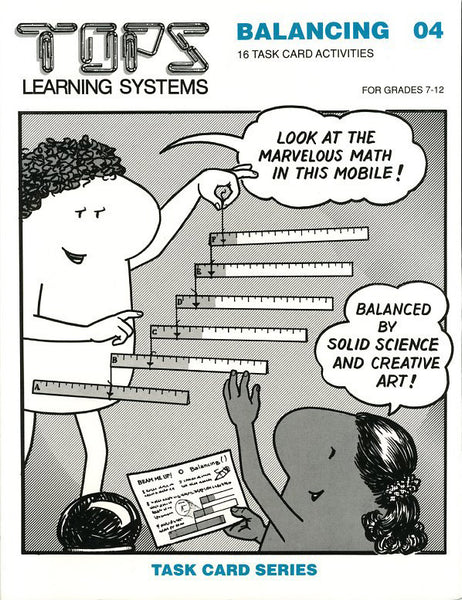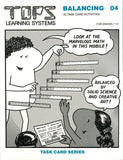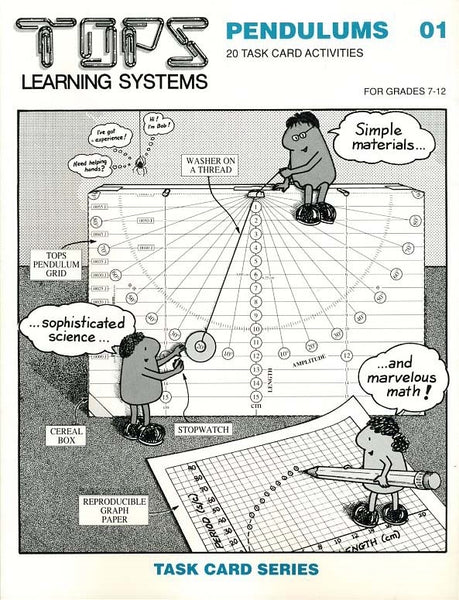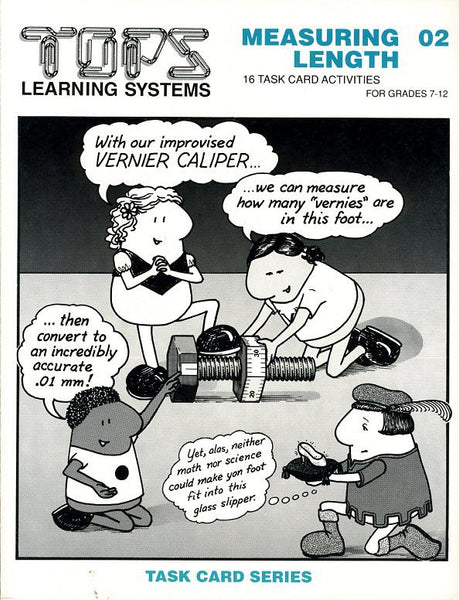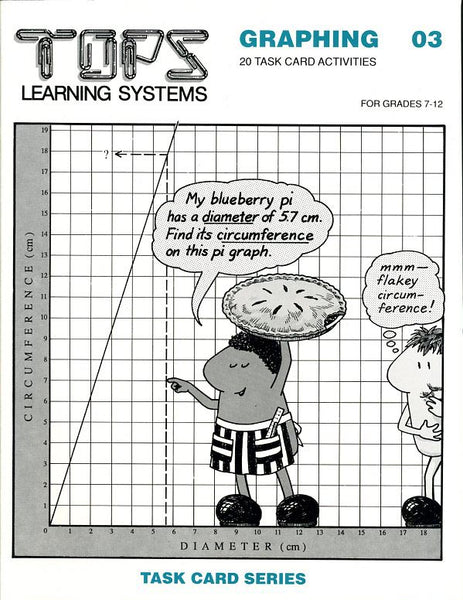#04 Balancing (grades 7-12)
Regular price $19.95
Soft-bound, 48 page book, 16 reproducible task cards, full teaching notes.
Can you balance on one foot? (Impossible if the side of your foot is pressed against the wall.) Can you balance a card on a pin? (Easy if you curve the card so its center of gravity is located below the pin point.) Discover the mathematics of balancing with clever mobiles and cantilevers; apply your knowledge to art and engineering. This is a multidisciplinary delight!
More Information – click any of the tabs below to learn more about this title
Click here for a complete list of materials and convenient shopping.
4x6 inch index cards, meter sticks, straight pins, medium-sized cans, pennies, masking tape, thread, scissors, paper clips, newspaper, size-D batteries, dead or alive, wooden clothespins, plastic drinking straws, rubber bands, medium-sized nails, assorted coins: pennies, nickels, dimes, quarters, clear tape, waxed paper, 10 mL graduates, hand calculator, wood, hammer and nails to construct a stable ground-level see-saw, bathroom scales, gallon plastic milk cartons with handles and lids, feet of cord or thin rope, large bowl- Lesson 1: To find the center of gravity (CG) of an index card. To understand why it shifts as mass is added to the card.
- Lesson 2: To use a plumb line to experimentally determine the CG of an irregular-shaped index card.
- Lesson 3: To observe that a standing object remains stable as long as its CG remains over its supporting base.
- Lesson 4: To feel your body lose stability as your CG shifts relative to your feet.
- Lesson 5: To define stable, unstable, and neutral equilibrium positions in terms of the displacement in an object's CG.
- Lesson 6: To observe how lowering the CG of an object below its pivot point stabilizes its equilibrium.
- Lesson 7: To construct an equal-arm balance beam. To use it to compare the relative masses of different coins.
- Lesson 8: To write mathematical equations that express a state of balance on a centered beam.
- Lesson 9: To increase the balance beam's sensitivity. To write more complex balance equations.
- Lesson 10: To develop a mass standard based on a 10 mL volume of water.
- Lesson 11: To use balance beam math to calculate the mass of unknown coins, based on the mass of known coins.
- Lesson 12: To construct a mobile and examine the mathematics of its design.
- Lesson 13: To experimentally determine the mass of the meter stick balance beam.
- Lesson 14: To cantilever beams beyond the edge of a support. To construct a mathematical series.
- Lesson 15: To calculate the weight of a friend on a balance beam, using your own weight as a standard of comparison.
- Lesson 16: To calculate your mass in kilograms using water jugs and a balance beam.
We encourage improvisation - it's one of the main goals of our hands-on approach! You and your students might invent a simpler, sturdier or more accurate system; might ask a better question; might design a better extension. Hooray for ingenuity! When this occurs, we'd love to hear about it and share it with other educators.
National Science Education Standards (NRC 1996)
Teachers of science...
A: ...plan an inquiry-based science program. (p. 30)
B: ...guide and facilitate learning. (p. 32)
C: ...engage in ongoing assessment of their teaching and of student learning. (p. 37)
D: ...design and manage learning environments that provide students with the time, space, and resources needed for learning science. (p. 43)
• Represent a central event or phenomenon in the natural world.
• Represent a central scientific idea and organizing principle.
• Have rich explanatory power.
• Guide fruitful investigations.
• Apply to situations and contexts common to everyday experiences.
• Can be linked to meaningful learning experiences.
• Are developmentally appropriate for students at the grade level specified.
Core Concepts/Processes: A balance beam is a predictable, mathematical, equilibrium system: The sum of products (weight x pivot distance) on one side of a balance beam equals the sum of these products on the opposite side.
Core Inquiries: Placing known weight on one side of a balance beam, calculate unknown weight on the opposite side.
Core Content: Center of gravity • Plumb lines • Stable, unstable and neutral equilibrium • Cantilevers • Mobiles • Balance beams • Sensitivity • Grams and kilograms
Core Content: Apply the mathematics of balance beams to cantilevers and mobiles.
TEACHING Standards
These 20 Activity Sheets promote excellence in science teaching by these NSES criteria:Teachers of science...
A: ...plan an inquiry-based science program. (p. 30)
B: ...guide and facilitate learning. (p. 32)
C: ...engage in ongoing assessment of their teaching and of student learning. (p. 37)
D: ...design and manage learning environments that provide students with the time, space, and resources needed for learning science. (p. 43)
CONTENT Standards
These 20 Activity Sheets contain fundamental content as defined by these NSES guidelines (p. 109).• Represent a central event or phenomenon in the natural world.
• Represent a central scientific idea and organizing principle.
• Have rich explanatory power.
• Guide fruitful investigations.
• Apply to situations and contexts common to everyday experiences.
• Can be linked to meaningful learning experiences.
• Are developmentally appropriate for students at the grade level specified.
Unifying Concepts and Processes
NSES Framework: Systems, order, and organization • Evidence, models and explanation • Constancy, change, and measurement • Evolution and equilibrium • Form and functionCore Concepts/Processes: A balance beam is a predictable, mathematical, equilibrium system: The sum of products (weight x pivot distance) on one side of a balance beam equals the sum of these products on the opposite side.
Science as Inquiry (content standard A)
NSES Framework: Identify questions that can be answered through scientific investigations. • Design and conduct a scientific investigation. • Use appropriate tools and techniques to gather, analyze, and interpret data. • Develop descriptions, explanations, predictions, and models using evidence. • Think critically and logically to connect evidence and explanations. • Communicate scientific procedures and explanations. • Use mathematics in all aspects of scientific inquiry.Core Inquiries: Placing known weight on one side of a balance beam, calculate unknown weight on the opposite side.
Physical Science (content standard B)
NSES Framework: Properties and changes of properties in matter • Motions and forcesCore Content: Center of gravity • Plumb lines • Stable, unstable and neutral equilibrium • Cantilevers • Mobiles • Balance beams • Sensitivity • Grams and kilograms
Science and Technology (content standard E)
NSES Framework: Abilities of technological design • Understanding about science and technologyCore Content: Apply the mathematics of balance beams to cantilevers and mobiles.

